Carol Newman Cronin's Blog, page 11
November 9, 2023
Why a Voiceless “Victory” Makes me So Proud
A few weeks ago, I sailed my last Snipe race of 2023—without a voice. I’ve written about voice before, but this time I mean it quite literally: I had laryngitis.
And in more than 30 years of top-end one design racing, I consider it one of my best finishes ever.
By the usual standards, crossing the finish line in third could be called a failure. Halfway through the race, we were winning—both the race and the North American Championship—so dropping two boats on the second lap hardly constitutes what legendary coach Gary Bodie would call a positive delta. But I’m really proud of finishing second overall, because on that particular day Kim Couranz and I had to use everything we’d learned in thirteen years of sailing Snipes together.
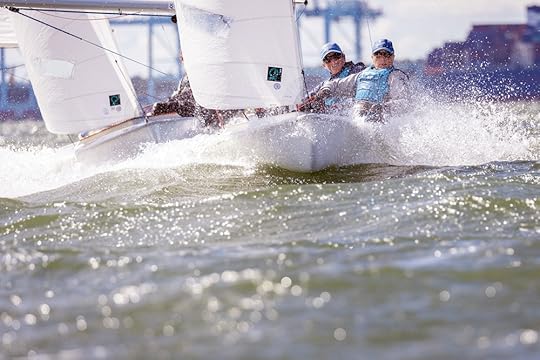 Reaching in heavy air requires perfect trimming and body positioning to keep the Snipe planing—and to avoid wiping out.
Reaching in heavy air requires perfect trimming and body positioning to keep the Snipe planing—and to avoid wiping out. We’d posted two first place finishes on the opening day of the regatta, and even after a much windier day two we led the results by one point going into the final day. As one of the lightest teams, we knew Sunday’s big breeze forecast would be a BIG challenge. Especially when I woke up that final morning without my voice, a key communication device.
On Friday, we’d joked about how we didn’t really need to talk anymore; after so many years as a team, just a grunt at the right time would be all that was necessary to convey what each of us was trying to say. But that Sunday, I couldn’t even grunt; I could barely whisper. And as we sailed out in a building northwest breeze, we knew the wind noise would overwhelm anything less than a shout.
Here’s why I’m so proud of how we sailed, and what can be learned from it.
We prepared wellJust before we left the dock, I noticed the tiller extension universal was halfway split through—and, though it would’ve been easy to put my blinders on and ignore it, instead I made the time to replace it. We left the dock a little later than I preferred… but an hour later when I tugged on the tiller extension hard to keep the boat from capsizing downwind, it stayed attached.
We kept doing USWe have so many hours in a Snipe together that Kim usually knows what I’m going to do next even before I quite realize it myself, so to compensate for my lack of voice she stepped up her own excellent communication to something approaching redline. Instead of waiting for me to speak, she’d ask, “Are you thinking of tacking?” That timely question would be followed by a glance aft, so I could convey my answer with just a nod.
We used all of our hard-earned Snipe wisdom and fitnessIn the biggest puffs, we had to flog both sails upwind to keep the boat from flipping. Even if I could speak, I wouldn’t have communicated that need fast enough; Kim had to feel for herself when flogging the jib was necessary, and because she never cleated the sheet her response was instantaneous. In those conditions, the jib is key to boat balance. So as soon as the puff faded, she had to pull it back in again—which required much more strength than the usual Sunday Snipe sailing promised in the brochures.
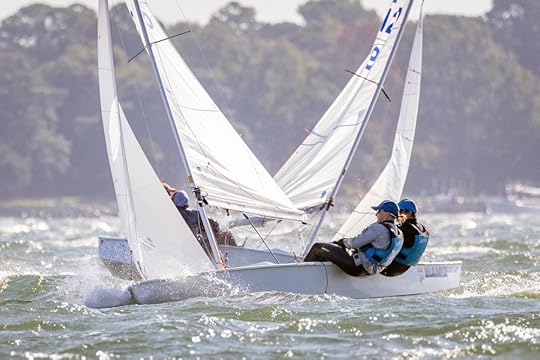 When we have to luff jib AND main upwind, it’s freakin’ windy. We never stopped racing—
When we have to luff jib AND main upwind, it’s freakin’ windy. We never stopped racing——even when a heavier team ground us down upwind. Even when we suffered a fatal pole failure that could’ve easily spiraled down into other calamities. We did lose one more boat downwind… but held onto second overall. And I’ve now added a new item to my very large Snipe bag of rigging tricks: the plastic ends should always be GLUED into the aluminum tube…
As sailboat racers, we never know when all of our skills—both physical and mental—will be required to succeed. All we can do is keep working out, continue to accumulate and share knowledge, and then be ready to do our thing on the biggest days—even when we wake up without a voice.
PS: Thanks to Ben Schill for the photos!
The post Why a Voiceless “Victory” Makes me So Proud appeared first on Carol Newman Cronin.
November 2, 2023
Book Review: The Half of It
Juliette Fay has written seven books, and I’ve read all of them. I first met her shortly after her second novel came out, and after reviewing that one I went back and read her first book. Since then I’ve devoured everything she’s published, including her two historical novels, within months of publication.
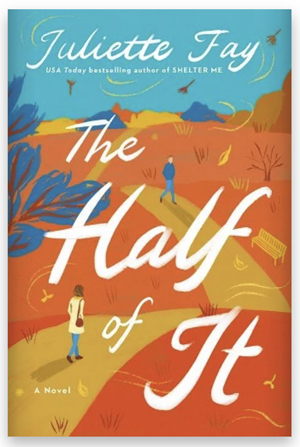
Her latest book is The Half of It. We first meet the main character, a 58 year old “accidental badass” named Helen, sitting in the woods with a granddaughter asleep in a backpack, contemplating her life. I’ve written before about Fay’s distinctive metaphors, which heighten awareness of character and setting without distracting from the story, and there’s a perfect example right on the very first page: “Her blank stare conjures only the wrong turns; regret is a thing with teeth.”
This regret turns to something that’s not quite rage when her first love unexpectedly appears, hot on the heels of his missing grandson. He doesn’t recognize her, and though Helen is somewhat relieved (because she’s carefully buried the memories of a bad ending to their teenage romance), “She actually feels bad for him. In forty years, she’s had not one moment of pity for Cal fucking Crosby, so it’s kind of interesting. Also, how does the bastard not recognize her? Honestly, this is the most interesting thing that’s happened to her in months.” In one paragraph, we get it—all of her mixed-up feelings for the one who got away 40 years earlier.
Fay publishes frequently, but she doesn’t try to keep up with the annual treadmill of many upmarket fiction authors. Perhaps because of this, the topics of her stories are a little more varied—even when they stick to present day. What doesn’t vary is the quality of both editing and storylines, which are as smooth as… well, Juliette, help me out here, because silk would be far too predictable; what would you suggest instead?
Like me, Fay was 45 when she published her first book—but she was also raising four kids. She wrote this book (her seventh) when she was the same age as Helen, and she’s just celebrated the milestone birthday that awaits me next year. In a lovely essay on Literary Hub, she first riffs on what turning 60 “feels like” before explaining what “older” really means, at least to the reviewers who included this book on a list entitled Books Featuring Charming Older Protagonists:
“Most of the other books on this list feature protagonists in their seventies, eighties, and nineties. They’re all good books, I’m sure, and again, lists—yay! But does Helen really belong here? And if not, where does she belong? Because no one is making lists of female protagonists, charming or otherwise, in their fifties and sixties. No one seems to know what to do with us…except us. And with all the attention given to younger, more fresh-faced main characters and “charming” senior ones, even we get confused sometimes.”
https://lithub.com/juliette-fay-on-writing-complex-older-protagonists/
None of us is too old to change, Fay reminds us, which is a common theme in her books. I recommend all of them for readers of any age who enjoy stepping into different lives, while being assured of a happy—not sappy—ending. Meanwhile, I can’t wait for her next story—and all of those unexpected but meaty metaphors.
Got a book recommendation, or even a favorite Juliette Fay book? Share your thoughts in the comments below, or send me an email. Thanks!
The post Book Review: The Half of It appeared first on Carol Newman Cronin.
October 26, 2023
Wingfoil Video: Jibing for the Paparazzi
Over the summer, Liz Baylis (hi Liz!) captured us wingfoiling from her dinghy. Now that Paul has edited her photos and video into a 3-minute show, I can check off one of my long-time fantasies; having my own personal paparazzi!
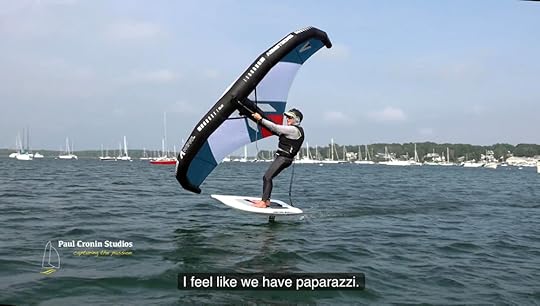
The last time I wrote about wingfoiling, I explained its cross-training benefits with Snipe sailing. One of my most popular posts (ever) included hindsight safety tips from an unexpected mishap. I’ve also explained how we incorporated a new sport into habits learned fifty years ago, and shared 5 reasons to start wingfoiling outside of the summer season. There are lots of lessons that apply to both other sailing and life in general.
This post is all about sharing the joy.When everything’s in balance, there is no water noise and the loads go incredibly light—the closest I will ever get to flitting across the harbor like a silent butterfly. Even the stumbles are fun, especially now that they’re not happening nearly as often. As Paul says, we are indeed Hooked on the Foil—partly because we’re doing it together.
So many people have asked me how hard wingfoiling is to learn, or how long it will take; I always struggle to answer, because they seem like the wrong questions. For me, the entire process brought joy; it didn’t matter how long it took to get to the point where I can now jibe and foil reliably. Yes, it’s more visibly fun now that I’m able to buzz my personal paparazzi—but the true secret is to enjoy each step along the way.
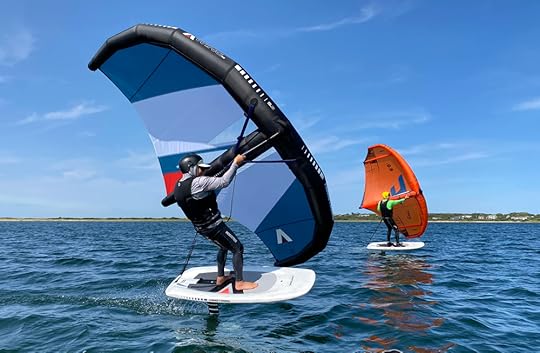
Got the urge to try wingfoiling? Leave a comment below, or email me; I’ll send along a few ideas to get you started. Thanks for reading!
The post Wingfoil Video: Jibing for the Paparazzi appeared first on Carol Newman Cronin.
October 19, 2023
Going Back to Sailing: Pierre for Sale
Sailing fans, you can keep reading. Paul and I are selling the powerboat named Pierre.
In May 2022, I informed you all (with just a touch of embarrassment) that we had added a Nauset 27 to the family, a Down East style boat powered only by fossil fuel. Now, after two summers, we are actively looking for Pierre’s next home.
And it’s not him; it’s us.
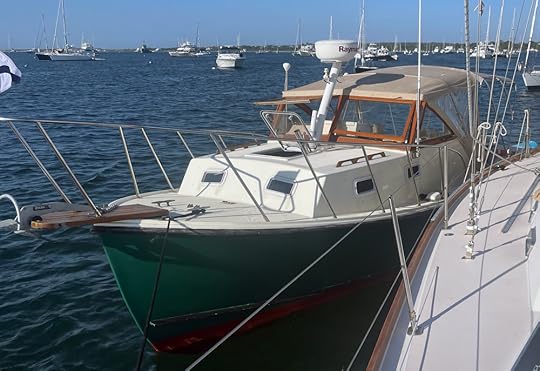
Why would two sailors buy a powerboat in the first place? The two primary goals were overnight cruises with a lower time commitment, and access to wingfoiling spots. I could also justify it as research, since the sequel to Ferry to Cooperation Island continues to revolve around a motorboat.
After two seasons, we can check all of those boxes. We had several fun adventures, including a weekend in Great Salt Pond (and we always slept great, thanks to a huge V-berth). We enjoyed a few quiet harbors we never would’ve bothered to explore on a sailboat. We did some great wingfoiling; I even used the versatile Pierre as a yoga platform. Last but not least… I now know exactly what it feels like to stand at a wheel for forty minutes in open water.
But each new location was bracketed by what basically felt like a delivery; pushing the throttle forward when we wanted to get there a bit faster, rather than setting more sail or trimming/steering more intently. We want to go back to enjoying the journey as much as the destination, and for us that means traveling by sailboat.
Pierre is a great boat and brought us many happy memories, but powerboaters we ain’t. We’re looking for a buyer interested in a most handsome lad with many recent upgrades: new bottom job, steering, plumbing. Interested? Here’s the ad that includes lots of photos, a video walkthrough, and a long list of details.
For the rest of you; got a story about an enjoyable ride on a—gasp—powerboat? Share it in the comments below, or (if that’s too public) send me an email. I read every single one, with gratitude.
The post Going Back to Sailing: Pierre for Sale appeared first on Carol Newman Cronin.
October 12, 2023
Cross Training for Sailing: Wingfoiling and Snipe Racing
One of the many things I love about my chosen sport is that there’s such a wide range of sailing craft. I’ve written before about how lucky I feel to embrace Whatever’s on Now, but today I want to share how spending time on one specialty unexpectedly helped me exceed my goals in another.
(Athletes call this cross-training.)

A few weeks ago I went to the Snipe Masters Nationals, my first dinghy regatta in four months—and I’m still shocked that supercrew Kate Fears and I blew right by our (unstated) goal to finish at the tippy top of the results. I’ve written before about the frustrations of, and lessons from, sailing on Mystic Lake, a small body of water outside Boston surrounded by trees and hills; the nicest thing I can say is that it definitely does NOT play to my personal strengths. But after three days and nine light-air races, Kate and I ended up tied for first with the regatta favorites—beating out 39 other teams!
It wasn’t until the day after the regatta, when Paul and I adjusted our work schedules to the forecast and snuck out for some Monday morning wingfoiling before a streaky northerly died, that it suddenly occurred to me: I’d spent the mostly light-air summer searching out puffs and dodging lulls, in order to get up—or stay up—on the foil. Honing that skill was what had helped me post my best finish ever on a small lake.
The biggest key to “success” in light air, regardless of craft, is to accurately read wind on water and then figure out how to “connect the dots.” Getting up on the foil requires 9 knots of breeze (and more is easier); 8 doesn’t cut it. In the Snipe, the difference in speed between a five knot puff and a four knot lull is equally significant to race results. Without realizing it, I’d been training for this regatta all summer.
Kim and I have two more regattas in 2023, so I’ll have plenty of opportunity to figure out how much my breeze-sniffing foiling skills actually help once waves return to the mix. Until then, I’m going to revel in the knowledge that “just for fun” wingfoiling definitely helped my Snipe results—at least on one tiny and very Mystical lake.
Got a cross-training story that led to unexpected success in your sport of choice? Share it in the comments below, or send me an email. I read every single one, with gratitude.
Results and more photos (thanks to Lexi Pline)
The post Cross Training for Sailing: Wingfoiling and Snipe Racing appeared first on Carol Newman Cronin.
October 5, 2023
Where I Get My Ideas: One Example
Perhaps the most frequently asked question posed to authors is this: “Where do you get your ideas?” Today, I’m going to dig into a specific example from Ferry to Cooperation Island—and then share what sparked this post.
Indelible memoryWhen I was eleven years old, we raced Katrina around the Elizabeth Islands on a perfect August Saturday. After a light-air beat up Buzzards Bay, the seabreeze filled in for a glorious spinnaker run down Vineyard Sound, to a finish somewhere off the entrance to Woods Hole. But with the current foul and quite strong, the best strategy was to hug the rocky island shores as closely as we dared.
(Just a reminder: there was no GPS.)
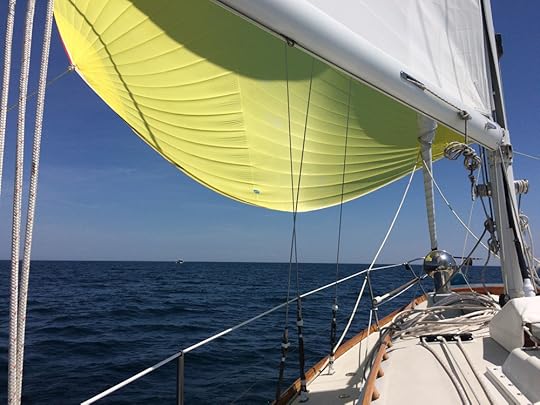 Spinnaker sailing on Katrina in 2018
Spinnaker sailing on Katrina in 2018About halfway down the run, one of the crew quietly suggested that we head up about fifteen degrees, to avoid a big rock lurking off the next point. So we eased the spinnaker guy forward, trimmed in the sheet, and altered course to starboard… until that same veteran calmly informed us that we were clear of the unseen danger and could resume our tight coast-hugging.
I don’t remember if we won the race, or anything else about that particular day; just that course alteration—all because of what we learned after the finish. Ten minutes behind us, one of our competitors (with an equally local and knowledgeable crew) had piled up on that very same rock—at full speed, under spinnaker. Though no one was hurt, the boat was damaged enough to end their season.
Putting it to workDecades later, that tiny but distinct memory resurfaced as the catalyst for the family feud between my main character James Malloy and “bad guy” Lloyd Wainwright. Desperate to understand their shared history, James learns from Mayor Frank exactly how Lloyd’s grandfather Willie had drowned. (I’ve edited the published version slightly for clarity.)
”I’ll never forget seeing those two boats coming around the corner,” Frank said, pointing toward the lighthouse. “The other boat was out in front, and it was so windy they didn’t set a spinnaker. Willie was desperate to win, so he put up a really big sail—and then ran straight up on Brenton Rock. The boat broke up in just a few minutes—they’d built her extra light for racing, of course.”
While the fictional details are much more tragic, the original inspiration for this scene can be traced straight back to that long-ago race memory.
 Why I’m writing about this now
Why I’m writing about this nowWhile digging through the K. Aage Nielsen archives, I spotted an old newspaper clipping about a race victory—by the very same boat that had piled up onto that rock. “An exceedingly rapid 40-foot sloop,” the New York Herald Tribune writer called her. And, for very different reasons, also an exceedingly memorable one—at least to a certain eleven year old.
I’ve written before about the melting-pot of my imagination, but I hope this specific example helps explain how memories can morph into backstory—and then inspire a blog post. It’s a rather convoluted path, turning historical facts into fictional details—but also a very fun excuse for another journey down memory lane.
Got a childhood memory that is unexplainably strong? Share it in the comments below, or send me an email. I read every single one, with gratitude.
Related postsHow to Find Writing Inspiration and Ideas
Ideas are the Easy Part: Teaching with Cape Cod Surprise
The Plot: Story-Borrowing or Story-Stealing?
In Search of Inspiration: Spring and Launching Season
Pause for Percolation: The Writing Brain
How to Stretch a Pantser Writer’s Brain
The post Where I Get My Ideas: One Example appeared first on Carol Newman Cronin.
September 28, 2023
Primary Source Research: The Dusty Joyousness of Deep Dives
A few weeks ago, I took a field trip to the Peabody Essex Museum’s reading room to dig into the files of Hound’s designer, K. Aage Nielsen. From 1935-1983, this prolific communicator filed away a wide variety of items for future reference: newspaper clippings about race wins, hand-written sketches of innovative design features, rating rule data, client and builder correspondence… even multiple copies of multi-page equipment brochures from a wide range of suppliers.

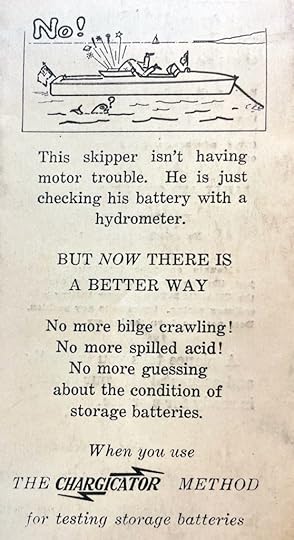 Courtesy of the Estate of K. Aage Nielsen and the Phillips Library, Peabody Essex Museum
Courtesy of the Estate of K. Aage Nielsen and the Phillips Library, Peabody Essex MuseumThe first struggle was to parse out which of the thirty-plus boxes might contain anything pertinent to Hound history, based only on a vague summary of their contents. But once I began leafing through each manila folder, the biggest challenge by far was to stay focused. How could I resist skimming the agenda of a long-forgotten measurement rule meeting, in search of my father’s name… or learning about the Chargicator… or reading a newspaper account about the 1965 race win of a competitor’s design—the same boat that had inspired a tiny piece of Ferry to Cooperation Island backstory? (More about that next week.) The hours joyously disappeared down the dusty rabbit hole of unexpected discoveries.
Driving home, I realized that an unexpected find on my last field trip had inevitably led to this one. In the spring of 2022, I’d gone in search of photos for 100 Years of Gold Stars, and also found a photo of K. Aage Nielsen. That’s the thing about primary research; I never really know what I’m looking for, but somehow I always find it—along with something else entirely, which might just inspire my next project.
Of course I also collected plenty of Hound-related details that have already helped me focus and enrich her history. But for now, I just want to savor the lucky luxury of diving deep into rabbit holes of my own choosing, even when they are not even remotely relevant to that day’s stated goals. After being so richly rewarded for my past dalliances, I’m absolutely certain that one of those seemingly inconsequential and unexpected finds in the papers of K. Aage Nielsen will someday, somehow, spark an equally unexpected story.
Stay tuned!
The post Primary Source Research: The Dusty Joyousness of Deep Dives appeared first on Carol Newman Cronin.
September 21, 2023
Book Review: The Starfish Sisters
When I interviewed Barbara O’Neal in February 2020, the Colorado native had recently published her first book of coastal fiction—and my fourth novel was not quite out. Since then, she’s published three more books that all take place on the coast… and I’m still working on the sequel to Ferry to Cooperation Island!

Her 2023 book, Starfish Sisters, just came out September 1 and has already received rave reviews. While it does adhere to her usual pattern (a strong female main character coming to terms with something that happened years earlier), this story is uniquely satisfying—thanks to the strength of O’Neal’s clear voice and detailed character development.
It opens with a short prologue, the timeline identified only as “Then,” which shows us “Joel” setting fire to a church after watching “Suze” and her father driving away. The next section, titled “six months ago;” is a newspaper clipping explaining that “Suze Ogden, Oscar and Emmy-award winning actress,” has been attacked by a hate group. Her prognosis is unclear. Only then does O’Neal launch us into “Chapter 1,” which is set in “current day” and narrated by someone named Phoebe. For the rest of the book, the chapters alternate between flashbacks to their teen years and “now.” (This is reinforced by the writing: “Then” sections are written in past tense, while the “current day” chapters are written in present tense.)
Phoebe and Suze have been closer than sisters since the summer they were twelve years old. Phoebe had to leave the small beach community for school each year, so they stayed in touch by passing a diary back and forth—until secrets and trauma break them apart. It’s only after Suze’s attack decades later that they try to rebuild their friendship.
There’s a love triangle from “then” as well as a budding new relationship, but the core of the story is the rekindling of this childhood friendship and the importance of forgiveness. The ending is pleasantly predictable, but the descriptions of the Oregon coastline neatly overlaid with inner monologues kept me turning the pages.
There were two small distractions: several repeats of information that slowed down the story, especially in the third quarter of the book; and the fact that I never really understood the motivations for the hate attacks against Suze. Perhaps that was the point, that there is often no good reason for such brutality. And it was somewhat comforting to realize that even such a polished author doesn’t always get the editing exactly right.
This book is recommended for coastal fiction readers who demand more of a “romance novel” than just a series of predictable he said, she said scenes. It makes me want to visit the Oregon coast—though I doubt I’ll ever move there, the way O’Neal did halfway through writing the book. As she puts it in the acknowledgements, “Sometimes a book changes your life.”
Got a coastal fiction read to recommend? Share it in the comments below, or send me an email. I read every single one, with gratitude.
The post Book Review: The Starfish Sisters appeared first on Carol Newman Cronin.
September 14, 2023
Great Salt Pond Has it All
A few Fridays ago, we loaded food, paddleboard, and wingfoil gear onto Pierre and headed out to Block Island. Usually we stay away until after Labor Day, but the chance to raft up with our friends Liz and Todd was too good to miss—especially since they had already scored a mooring.
(Little did we know it would be the perfect place to mourn Jimmy Buffett’s passing.)
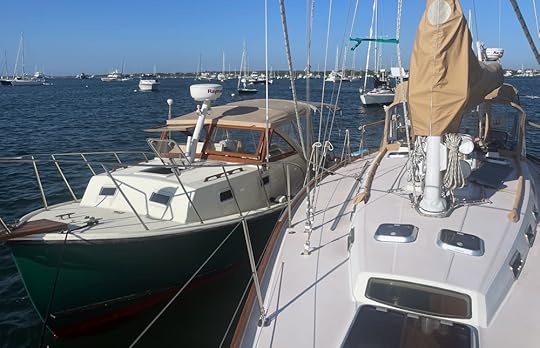
It was a relaxing wind-down to a fantastic summer, with leisurely morning paddles followed by reading in the shade. Once the afternoon seabreeze filled, Paul and I launched our wings and foils from Pierre’s spacious cockpit and beelined for the piece of open water that is “blocked” off for watersports. Even on one of the most crowded weekends of the year, we were able to enjoy wingfoiling without worrying (too much) about boat traffic—and later, thanks to Liz and her photography skills, some great action shots.
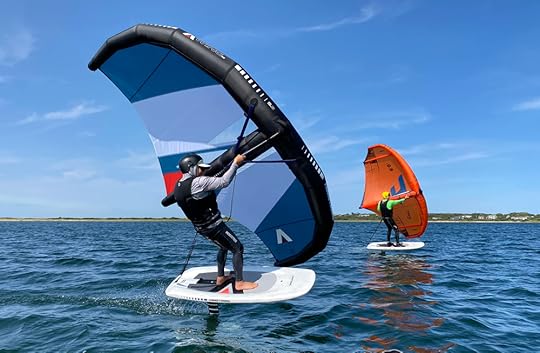 Synchronized wingfoiling: Future Olympic sport? Photo: Liz Baylis
Synchronized wingfoiling: Future Olympic sport? Photo: Liz BaylisGreat Salt Pond has a reported capacity for 1500 boats, and that weekend there was at least one example of every type of vessel capable of crossing open water. Classic and modern sailboats. Cruising catamarans. Motoryachts large and larger. And, only a few hundred yards upwind of the beach, several jaw-dropping rafts of smaller powerboats—each with a generator on the bow. (Apparently not everyone regards cruising as a chance to get away from all the “conveniences” and noise of shore life.)
Every time I paddled or foiled back “home” to our own two-boat raft, I realized how odd our particular pairing must appear: a cruising sailboat that had adopted a small but scruffy Down East powerboat. Of course we’re all sailors at heart, but anyone waving from a passing dinghy would quite rightly think of the couple sitting in Pierre’s cockpit as “stinkpotters.”
There are as many different ways to enjoy cruising as there are boat designs, and I’m grateful to Pierre for providing such a perfect platform for both wingfoiling and relaxation. I’m perhaps even more grateful to Liz and Todd for their “mothership,” where we could sink into cockpit cushions for cocktails and dinner. There is so much focus on the different lifestyles of Power vs. Sail… and yet there we were, happily sharing our little piece of the harbor.
Can world peace be far behind?
The post Great Salt Pond Has it All appeared first on Carol Newman Cronin.
September 7, 2023
Farewell to Jimmy Buffett
As Ferry to Cooperation Island was going to press, the publisher asked if there was anything special I’d like to add to the opening pages. All I could think of was the song that had played in my head as I was writing and editing: “Island,” by Jimmy Buffett.
So, after gratefully receiving permission, I included the lyrics in the front matter.
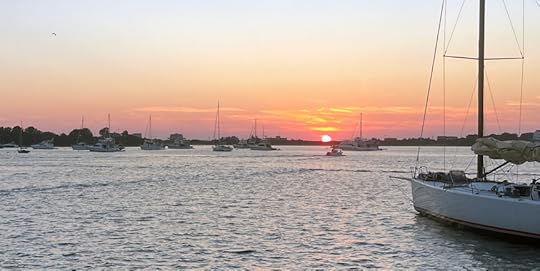
There is, of course, a Jimmy Buffett song for just about every occasion (and several great books too), so it should be no surprise that he’d already covered what I was trying to convey in my fourth novel: the push-pull between isolation and insulation of life on a small island. And now that he’s gone on to the great harbor in the sky, it should be even less of a surprise how huge the hole is that he’s left behind.
I know of no other person so universally loved by sailors and powerboaters alike. I don’t consider myself a Parrothead, but I can sing along with hundreds of his songs—and each one takes me right back to the moment when I first heard it. As a teenager and twenty-something, I spent way too many hours trying to decide which One Particular Harbor was actually my personal favorite—before realizing that having several candidates was okay, because metaphors are actually more effective if they’re not taken too damn literally. Another album seemed to have been written just for the breakup I was living through at the time; an excellent example of Buffett’s ability to cover universal themes in personal, memorable words that made everyone feel like he “saw” us.
Losing this icon just as another Labor Day weekend rolled around seemed especially poignant. Rafted with friends in one of Buffett’s own favorite harbors, we listened all day to a smorgasbord of his music—and caught earfuls of familiar tunes from nearby boats, both power and sail. That evening, over Boat Drinks and a cockpit feast of Cheeseburgers in Paradise, we shared stories of favorite albums and live concerts and unexpected Buffett regatta sightings. While all around us, we were certain that other sailors (and powerboaters too) were sharing similar stories and sightings and sighs.
In a world where so many things divide us, Jimmy Buffett united us all with a common dream: escaping on a boat to a tropical paradise. As we say goodbye to an era, a life’s soundtrack, and the man who made so many of us laugh and cry about a life well lived on the water, I’m going to let him take us out with the words that have been playing in my head ever since I heard the sad news:
“It was a pleasure and a hell of an evening; truly was our night to win. But the authorities insist on my leaving… take care, my American friend.”
The post Farewell to Jimmy Buffett appeared first on Carol Newman Cronin.



